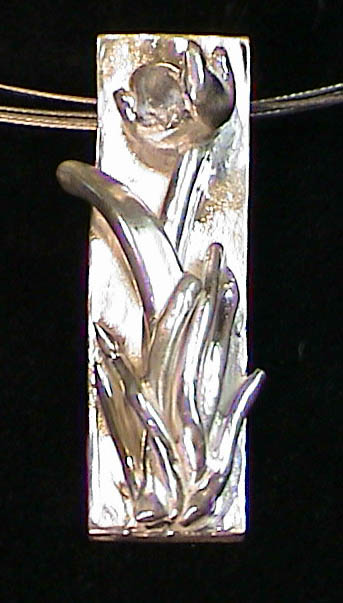 |
|
|
Kiln Pointers
|
|
|
Applying Ceramic Techniques to Metal Clay |
CONTENTS Applying Ceramic Techniques to Metal Clay RECENT Q&As: FTL message Firing multiple shelves in a glass kiln -------------- APPLYING CERAMIC TECHNIQUES TO METAL CLAY By Sallie Bly Connie Bailes teaches hand-built flowers to ceramic artists. Recently I asked her to teach a class in small flowers to metal clay artists in my studio. But she said she did not know how to work with metal clay. I explained that if she taught my students to make the flowers in porcelain, they could use the same techniques to make the flowers in metal clay. We had a great class with spectacular results in porcelain and later in metal clay. Most metal clay teachers encourage students to work with polymer clay. It is a great way to work out your design, because you can reuse your polymer over and over again until it is baked. When you are happy with a design, you can bake it and use it for a mold. So why would you want to work with ceramic clay? Because there are great ceramic clay tools and techniques that have been around for decades. Ceramic artists have been hand-building for a long time. Although the ceramic clay has a longer window of time before it dries, it works and feels a lot like metal clay. There are so many other great techniques that you can learn and practice with ceramic clay before making your final project in metal clay. Wax resist, cut outs, and clay lifting are just a few that the metal clay artist can borrow from the ceramic artist. Helpful hint to those who are doing enameling on metal clay: Traditionally creating the recessed areas on the metal for Champleve requires using chemicals and waiting for them work. With wax resist and metal clay, this process takes only a few minutes. To create the recessed areas for Champleve, use wax resist to maintain the top part of the silver project. Then use a sea sponge to remove the area that needs to be recessed. After firing, you have a great piece of metal to enamel. When playing with ceramic clay and you get a result that you like, you can fire it and make a mold from it. You can also glaze it and have your project in ceramics as well as in metal clay. Attend local ceramic shows. You will see a lot that you can incorporate into your metal clay. You will also find tools that you can use with metal clay. Members of the ceramic organization are usually available to answer questions. Ask where you can take hand-building ceramic classes. ------------- RECENT Q&As Q. In Cone-Fire mode, I set my Sentry 2.0 controller to cone 5. It ran for 15 hours and shut itself off with FTL on the digital readout. When I opened the kiln, the glazes looked great, just like they had gone to temperature like they were supposed to. I started the kiln about 9:00 last night for a cone 5 firing, and it again did the 15 hours and FTL thing. It says it got up to about 2109 degrees F. Can you tell me what is going on here? A. FTL means "Firing Too Long." This may indicate that your elements are wearing out. I suggest using witness cones in your next firings. When the kiln no longer fires your ware to maturity, then it would be time to replace the elements. Q. I fire a full shelf with a half shelf of glass in my Fusion-8 glass kiln. I was advised that because the kiln has sidewall and lid elements, glass could be fused using both shelves at the same time. The half shelf is supported on 2” posts to allow air circulation. Pieces on the half shelf have slightly irregular edges, whilst anything placed underneath and in its shadow is not fused completely. Work on the rest of this lower shelf is perfect. A. The Fusion-8 is designed to fire a single shelf of glass. The main heat comes from the lid elements. We added the sidewall element to improve heat distribution of a single shelf. Nevertheless, you could fire a full shelf and half shelf by designing both low-fuse and high-fuse glass pieces. Place the low-fuse pieces on the cooler area of the bottom shelf. Slowing down the firing may improve heat distribution. You might also get better results by experimenting with the height of the posts that support the half shelf. -------------- Today we are holding a two-day kiln maintenance seminar here in the Mesquite, Texas factory. Frances Darby, the company founder, taught the first ones that I attended. During a seminar one year, I worked at a light table in the background while listening to her teach the class. Students sat nearby while I cut and taped film for a catalog, the light from the glass table glowing softly. In every seminar, Frances Darby painstakingly explained the difference between the green grounding wire and the white grounded wire. She emphasized “ing” and “ed” as would a school teacher in a language class. She finally started calling the white wire the “line neutral” instead of the “grounded wire” to avoid confusion. Perhaps you can attend our next in-plant seminar. In the mean time, thank you for reading the Kiln Pointers and allowing me, in a small way, into your life. Thank you, With best wishes, Arnold Howard Paragon Industries, L.P. - Better Designed Kilns 2011 South Town East Blvd. Mesquite, TX 75149-1122 Voice: 972-288-7557 & 800-876-4328 / Fax: 972-222-0646 ahoward@paragonweb.com / www.paragonweb.com Copyright 2007, by Paragon Industries, L.P.
|
|
|

|
|
|
|
|
“Custom and standard Kilns and Industrial Furnaces for ceramics, pottery, heat treating, enameling, |
||||
